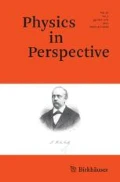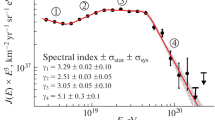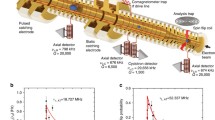Abstract
This paper is the first investigation of the events associated with the discovery of the antiproton. The 1955 observation of the antiproton by Owen Chamberlain, Emilio Segrè, Clyde Wiegand, and Thomas Ypsilantis was “no surprise,” in Chamberlain’s words, and might therefore be understood as a classic example of an experimental proof of an existing theory—except there was no complete theory—at best it was a further validation of Dirac’s 1930 prediction of antiparticles. Instead, I argue, it became a contest between the serendipitous observations of cosmic-ray events and the deliberate observation possible with the new accelerator-based experiments. I show that the discovery was an extended event and was seen by the physicists involved as emerging from a combination of supporting experiments—the counter-based detection of antiprotons was accepted as proof of discovery only with the supporting images of antiproton annihilations.




Similar content being viewed by others
Notes
Hyperon at this time was a loose term referring to any particle with a mass greater than that of a proton, as compared to its more precise term in modern particle physics where it is a baryon containing one or more strange quarks, but no charm, bottom, or top quark. This compares to mesons, “middle” particles, which at the times referred to particles of mass intermediate to electrons and protons.
Schein’s name was consistently misspelt throughout the article as “Schien.”.
In 1950 the abbreviation “BeV” (billion electron volts) was in general use in the United States of America to represent 109 eV, hence the name “Bevatron” of the Berkeley accelerator. By 1960, the internationally accepted alternative “GeV” (giga-electron-volt) had taken over.
References
Owen Chamberlain, Emilio Segrè, Clyde Wiegand, and Thomas Ypsilantis, “Observation of Antiprotons,” Physical Review 100, no. 3 (1955), 947–50, on 947.
Paul A. M. Dirac, “Quantised Singularities in the Electromagnetic Field,” Proceedings of the Royal Society of London. Series A, Containing Papers of a Mathematical and Physical Character 133, no. 821 (1931), 60–73, on 62.
Owen Chamberlain, “The Discovery of the Antiproton,” in Laurie M. Brown, Max Dresden, and Lillian Hoddeson, eds., Pions to Quarks: Particle Physics in the 1950s, 273–84 (Cambridge: Cambridge University Press, 1989).
For example: Xavier Roqué, “The Manufacture of the Positron,” Studies in the History and Philosophy of Modern Physics 28, no. 1 (1997), 73–129; Michelangelo De Maria and Arturo Russo, “The Discovery of the Positron,” Rivista di storia della scienza 2 (1985), 237–86; Norwood Russell Hanson, “Discovering the Positron (I),” The British Journal for the Philosophy of Science 12, no. 47 (1961), 194–214; “Discovering the Positron (II),” The British Journal for the Philosophy of Science 12, no. 48 (1962), 299–313.
For example: Blas Cabrera and W. Peter Trower, “Magnetic Monopoles: Evidence since the Dirac Conjecture,” Foundations of Physics 13, no. 2 (1983), 195–215; Helge S. Kragh, “The Concept of the Monopole: A Historical and Analytical Case-Study,” Studies in the History and Philosophy of Science 12, no. 2 (1981), 141–72; Andrew Pickering, “Constraints on Controversy: The Case of the Magnetic Monopole,” Social Studies of Science 11, no. 1 (1981), 63–93.
“Discover Anti-Proton,” Science News-Letter 65 (1954), 309. Science News-Letter is an American weekly magazine devoted to short articles about new scientific and technical developments, typically gleaned from recent scientific and technical journals. The articles are quite often without a byline—as was the case in this article. Published since 1922 by a non-profit organisation, the Society for Science and the Public, Science News-Letter changed its name to Science News in March 1966—https://www.sciencenews.org.
Herbert S. Bridge, Hans Courant, Herbert DeStaebler Jr., and Bruno Rossi, “Possible Example of the Annihilation of a Heavy Particle,” Physical Review 95, no. 4 (1954), 1101–3.
Evans Hayward, “Ionization of High Energy Cosmic-Ray Electrons,” Physical Review 72, no. 10 (1947), 937–42.
Marcel Schein, David M. Haskin, and Robert G. Glasser, “Narrow Shower of Pure Photons at 100 000 Feet,” Physical Review 95, no. 3 (1954), 855–57.
Edoardo Amaldi, Carlo Castagnoli, Giulio Cortini, Carlo Franzinetti, and Augusta Manfredini, “Unusual Event Produced by Cosmic Rays,” Il Nuovo Cimento 1, no. 3 (1955), 492–500.
Robert D. Hill, Stig D. Johansson, and F. T. Gardner, “Nuclear Emulsion Observation of Annihilation of an Antiproton,” Physical Review 101, no. 2 (1956), 907–9.
Owen Chamberlain, Warren W. Chupp, Gerson Goldhaber, Emilio Segrè, Clyde Wiegand, Edoardo Amaldi, Giustina Baroni, Carlo Castagnoli, Carlo Franzinetti, and Augusta Manfredini, “Antiproton Star Observed in Emulsion,” Physical Review 101, no. 2 (1956), 909–10; “On the Observation of an Antiproton Star in Emulsion Exposed at the Bevatron,” Il Nuovo Cimento 3, no. 2 (1956), 447–67.
Herbert S. Bridge, David O. Caldwell, Yash Pal and Bruno Rossi, “Further Analysis of the Massachusetts Institute of Technology Antiproton Event,” Physical Review 102, no. 3 (1956), 930–31.
Owen Chamberlain, “The Early Antiproton Work: Nobel Lecture, December 11, 1959,” in Nobel Committee, ed., Nobel Lectures, Physics 1942–1962 (Amsterdam: Elsevier Publishing Company, 1964), 489–505.
Kevin Orrman-Rossiter and Kristian Camilleri, “The Emergence of the Positron,” Unpublished manuscript, (2020).
G. Gamow, “The Negative Proton,” Nature 135, no. 3421 (1935), 858–61, on 858.
Gamow, “Negative Proton” (ref. 16), 861.
Engelbert Broda, Norman Feather, and Denys H. Wilkinson, “A Search for Negative Protons Emitted as a Result of Fission,” in International Conference on Fundamental Particles and Low Temperatures, vo. 1, Fundamental Particles, 114–25 (Cavendish Laboratory, University of Cambridge: The Physical Society, 1947).
Niels Arley, “On the Possible Existence of Negative Protons in the Primary Component of Cosmic Radiation,” Physica 12, no. 4 (1946), 177–83; “A Note on the Proton Hypothesis of the Primary Component of Cosmic Rays,” Physical Review 70, no. 11–12 (1946), 975–76; Leo Ponisovsky, “Radioactivity and the Completion of the Periodic System,” Nature 152, no. 3850 (1943), 187–88; Gamow, “Negative Proton” (ref. 16); George Gamow, “Negative Protons and Nuclear Structure,” Physical Review 45, no. 10 (1934), 728–29; James H. Bartlett, “Negative Protons in the Nucleus?,” Physical Review 46, no. 5 (1934), 435.
Charles L. Critchfield, “Excited States of Nuclear Particles in the Meson-Pair Theory,” Physical Review 59, no. 1 (1941), 48–52; Homi J. Bhabha, “Protons of Double Charge and the Scattering of Mesons,” Physical Review 59, no. 1 (1941), 100–101.
Gamow, “Negative Proton” (ref. 16), 859.
For example: Peter Galison, “The Discovery of the Muon and the Failed Revolution against Quantum Electrodynamics,” Centaurus 26, (1983), 262–316. Carl D. Anderson, “Early Work on the Positron and Muon,” American Journal of Physics 29, no. 12 (1961), 825–30.
Hayward, “Cosmic-Ray Electrons” (ref. 8); Evans V. Hayward (February 17, 1922–March 2, 2020) was an American physicist, who from 1950 to 1990 worked at the National Institute of Standards and Technology (NIST), where she made important contributions to the experimental measurements of photon cross-sections on nuclei. This work formed part of her PhD from the University of California, which she was awarded in 1947. There are a few brief references to her work on the web; I found this most useful: “Evans V. Hayward,” (Gaithersburg, MD: National Institute of Standards and Technology, 2019), https://www.nist.gov/history/radiation-physics-building/staff/evans-v-hayward, last accessed August 14, 2020.
Hayward, “Cosmic-Ray Electrons” (ref. 8), 937.
Hayward, “Cosmic-Ray Electrons” (ref. 8), 941.
Bridge et al., “Annihilation of a Heavy Particle” (ref. 7).
Bridge et al., “Annihilation of a Heavy Particle” (ref. 7), 1102.
“Discover Anti-Proton,” Science News-Letter (ref. 6), 309.
Herbert S. Bridge, Charles Peyrou, Bruno Rossi, and Richard Safford, “Cloud-Chamber Observations of the Heavy Charged Unstable Particles in Cosmic Rays,” Physical Review 90, no. 5 (1953), 921–33.
Wayne E. Hazen, “Energy of Electrons or Photons from Their Cascade Showers in Copper,” Physical Review 99, no. 3 (1955), 911–14.
David O. Caldwell, “Range-Energy Relation and Masses of the New Particles,” Physical Review 100, no. 1 (1955), 291–94.
Bridge et al., “Further Analysis” (ref. 13), 931.
George W. Clark, “The Contributions of Bruno B. Rossi to Particle Physics and Astrophysics,” in Proceedings of XXV Congresso Nazionale di Storia della Fisica e dell’Astronomia (Milano: SISFA, 2005), R1.1–R1.16.
Schein et al., “Shower of Pure Photons” (ref. 9), 855.
Schein et al., “Shower of Pure Photons” (ref. 9), 857.
Carl D. Anderson, “The Apparent Existence of Easily Deflectable Positives,” Science 76, no. 1967 (1932), 238–39.
Anna Debenedetti, Carola M. Garelli, Lucia Tallone, and Maria Vigone, “Detailed Analysis and Discussion of Two Narrow Showers of Pairs of Charged Particles,” Il Nuovo Cimento (1955–1965) 2, no. 2 (1955), 220–30.
James McConnell and Joseph Spelman, “Production of Negative Protons in the Atmosphere,” Il Nuovo Cimento (1955–1965) 4, no. 2 (1956), 836–47.
“The Anti-Proton,” Current Science 23, (1954), 247. Current Science is a “fortnightly journal of research” (http://www.currentscience.ac.in), this English language journal was established in 1932 and is published by the Current Science Association in collaboration with the Indian Academy of Sciences.
“The Anti-Proton,” Current Science (ref. 39), 247.
Amaldi et al., “Unusual Event” (ref. 10).
Amaldi et al., “Unusual Event” (ref. 10), 497.
Amaldi et al., “Unusual Event” (ref. 10), 497–98.
Amaldi et al., “Unusual Event” (ref. 10), 499.
B. D. Hyams, “Search for Anti-Protons Produced by High Energy Cosmic Ray Particles” (PhD disseration, University of Manchester, 1955).
Peter Galison, How Experiments End (Chicago: University of Chicago Press, 1987), 330.
M. Stanley Livingston, John P. Blewett, G. Kenneth Green, and Leland J. Haworth, “Design Study for a Three‐Bev Proton Accelerator,” Review of Scientific Instruments 21, no. 1 (1950), 7–22.
William M. Brobeck, “Design Study for a Ten‐Bev Magnetic Accelerator,” Review of Scientific Instruments 19, no. 9 (1948), 545–51; Edward J. Lofgren, “The Proton Synchrotron,” Science 111, no. 2882 (1950), 295–300.
Matthew Sands, “The Making of an Accelerator Physicist,” in Brown, Dresden, and Hoddeson, eds., Pions to Quarks (ref. 3), 149–61.
Peter Galison, Image and Logic: A Material Culture of Microphysics (Chicago: University of Chicago Press, 1997).
John P. Blewett, “Accelerator Design and Construction in the 1950s,” in Brown, Dresden, and Hoddeson, eds., Pions to Quarks (ref. 3), 162–79.
Emilio Segrè, interview with Charles Weiner and Barry Richman, February 13, 1967, Niels Bohr Library and Archives, American Institute of Physic, College Park, MD, https://www.aip.org/history-programs/niels-bohr-library/oral-histories/4876.
Gerson Goldhaber, “Early Work at the Bevatron: A Personal Account,” in Brown, Dresden, and Hoddeson, eds., Pions to Quarks (ref. 3), 260–72. The conference, the Second International Symposium on the History of Particle Physics, was held at Fermilab on May 1–4, 1985. Lectures and discussions of the physicists and historians were published as Brown, Dresden, and Hoddeson, eds., Pions to Quarks (ref. 3).
Oreste Piccioni, “On the Antiproton Discovery,” in Brown, Dresden, and Hoddeson, eds., Pions to Quarks (ref. 3), 285–95, on 285.
Piccioni, “Antiproton Discovery,” (ref. 54), 285. In 1972 Oreste Piccioni initiated a lawsuit against Segrè and Chamberlain, claiming he revealed a design for the antiproton experiment to Segrè and Chamberlain in December 1954 after the men had agreed to work together with him on the experiment on the Bevatron. Gloria B. Lubkin, “Piccioni Sues for Share of Antiproton Credit,” Physics Today 25, no. 9 (1972), 69–71. The Court of Appeals dismissed the case due to statute of limitations without hearing it on its merits. Piccioni, “Antiproton Discovery” (ref. 54), 285
Goldhaber, “Early Work” (ref. 53), 261–25.
Chamberlain, “Discovery of the Antiproton” (ref. 3), 276.
Donald H. Stork, Robert W. Birge, Roy P. Haddock, Leroy T. Kerth, Jack Sandweiss, and Marian N. Whitehead, “Search for Antiprotons,” Physical Review 105, no. 2 (1957), 729–30.
Walter H. Barkas, Robert W. Birge, Warren W. Chupp, A. Gösta Ekspong, Gerson Goldhaber, Sulamith Goldhaber, Harry H. Heckman, Donald H. Perkins, et al., “Antiproton-Nucleon Annihilation Process (Antiproton Collaboration Experiment),” Physical Review 105, no. 3 (1957), 1037–58.
Graham Hale, Owen Chamberlain: Physicist at Los Alamos, Berkeley Professor, 1950–1989, and Nobel Laureate (Berkeley: University of California, Regional Oral History Office, History of Science and Technology Program, the Bancroft Library, 1976), 176.
Jack Steinberger, “A Particular View of Particle Physics in the Fifties,” in Brown, Dresden, and Hoddeson, eds., Pions to Quarks (ref. 3), 307–30, on 307.
Erik Hulthén, “Introduction to Laureates, 1959,” in S. Stuart, ed., Nobel Lectures, Physics 1942–1962 (Amsterdam: Elsevier Publishing Company, 1964), 636.
Chamberlain, ”Observation of Antiprotons” (ref. 1), 948.
Chamberlain, ”Observation of Antiprotons” (ref. 1), 947.
John Marshall, “Cerenkov Counters,” Annual Review of Nuclear Science 4, (1954), 141–46.
John M. Brabant, Bruce Cork, Nahmin Horowitz, Burton J. Moyer, Joseph J. Murray, Roger Wallace, and William A.Wenzel, “Terminal Observations on ‘Antiprotons,’” Physical Review 101, no. 1 (1956), 498–501; “Interactions of Antiprotons in Lead Glass,” Physical Review 102, no. 6 (1956), 1622–26.
Goldhaber, “Early Work” (ref. 55), 267.
“Anti-Proton Discovered,” The Science News-Letter 68, (1955), 275.
Chamberlain, “Owen Chamberlain” (ref. 60), 176.
Piccioni, “Antiproton Discovery” (Ref 54.), 290.
Hill, “Nuclear Emulsion Observation” (ref. 11).
Chamberlain, “Antiproton Star” (ref. 12).
Chamberlain, “Antiproton Star” (ref. 12), 909.
Chamberlain, “Antiproton Star” (ref. 12), 910.
“Anti-Proton Seen for the First Time,” The Science News-Letter 68 (1955), 403.
Chamberlain, ”Antiproton Star ” (ref 12).
Chamberlain, “Antiproton Star” (ref. 12), 461
Gerson Goldhaber, interview with Ursula Pavlish, June 22, 2005, Niels Bohr Library & Archives, American Institute of Physics, College Park, MD, https://www.aip.org/history-programs/niels-bohr-library/oral-histories/34508-1.
Owen Chamberlain, Warren W. Chupp, A. Gösta Ekspong, Gerson Goldhaber, Sulamith Goldhaber, Edward J. Lofgren, Emilio Segrè, Clyde Wiegand, et al., “Example of an Antiproton-Nucleon Annihilation,” Physical Review 102, no. 3 (1956), 921–23.
Goldhaber, “Early Work” (ref. 53), 269.
Goldhaber, interview with Pavlish (ref. 79).
Segrè, interview with Weiner and Richman (ref. 53).
Allan Franklin, Shifting Standards: Experiments in Particle Physics in the Twentieth Century (Pittsburgh: University of Pittsburgh Press, 2013), provided further detailed examination of the changes in “necessary and sufficient conditions” for high-energy physics discoveries in this illuminating 2013 book. Of particular relevance is the prologue “The Rise of the Sigmas,” where he discusses the changes in both journal policy and unwritten laboratory policy, regarding the need for a “five-standard-deviation-effect” before “discovery” results were claimed in public.
Author information
Authors and Affiliations
Corresponding author
Additional information
Publisher's Note
Springer Nature remains neutral with regard to jurisdictional claims in published maps and institutional affiliations.
Kevin Orrman-Rossiter is a PhD candidate at the University of Melbourne, specializing in the history and philosophy of modern physics, focusing on antimatter, space exploration and the Nobel Prizes in physics.
Rights and permissions
About this article
Cite this article
Orrman-Rossiter, K. Observation and Annihilation: The Discovery of the Antiproton. Phys. Perspect. 23, 3–24 (2021). https://doi.org/10.1007/s00016-021-00271-7
Accepted:
Published:
Issue Date:
DOI: https://doi.org/10.1007/s00016-021-00271-7




